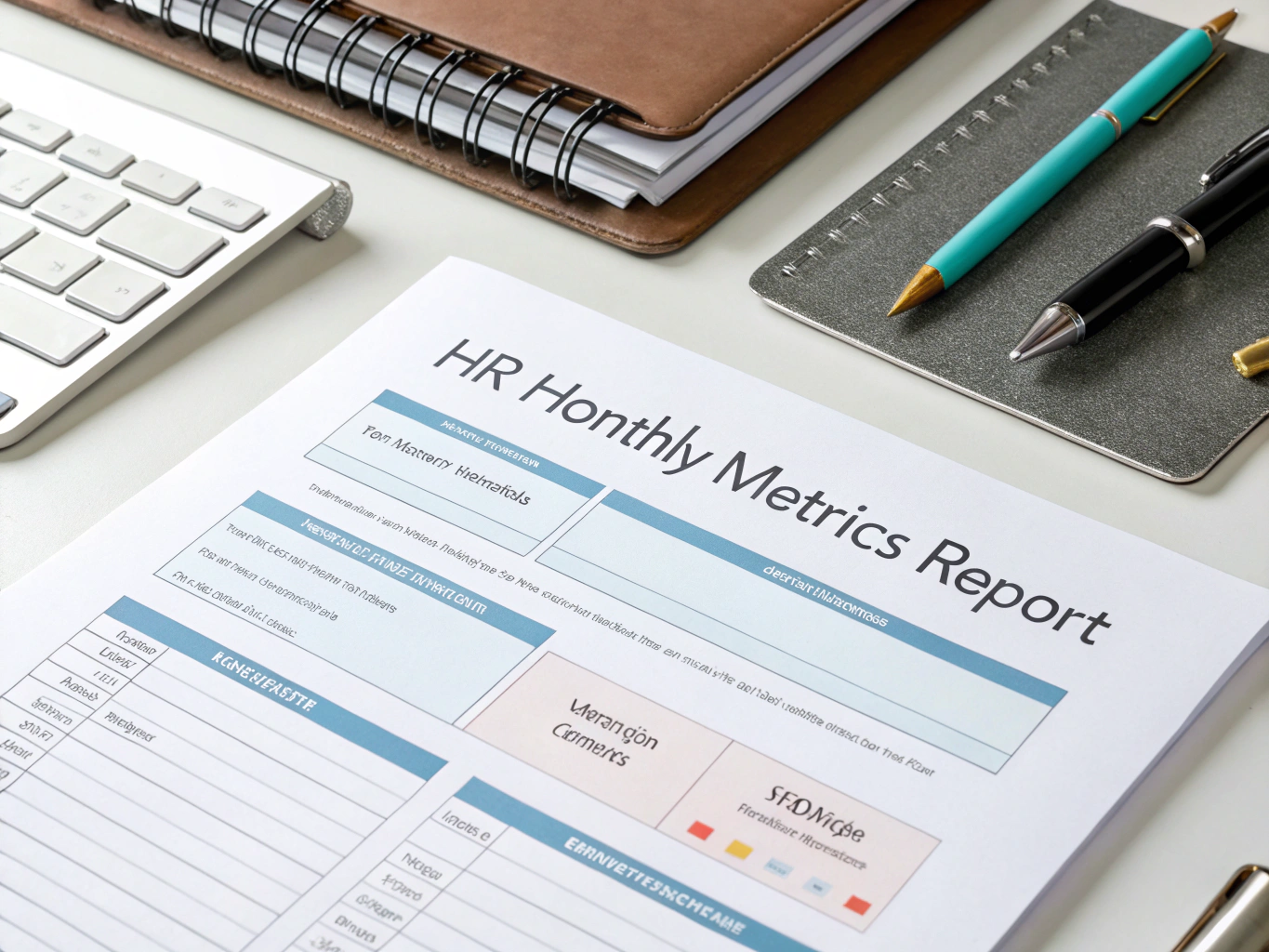What is a HR Department Monthly Metrics Report?
The HR Department Monthly Metrics Report is a crucial document that provides an overview of key performance indicators within the human resources department. This report is generated on a monthly basis to assess workforce dynamics, recruitment effectiveness, employee retention, and training impact. By compiling critical metrics, HR professionals can identify trends, address challenges, and make data-driven decisions that align with organizational goals.
Template
Below is a template you can customize for your organization’s needs:
HR Department Monthly Metrics Report
Month: [Month, Year]
Prepared by: [Your Name]
Date: [Report Date]
1. Executive Summary
Provide a brief overview of the key highlights from the month, including major trends, concerns, and achievements.
- Total Employees: [Total number of employees]
- New Hires: [Number of new hires]
- Attrition Rate: [Attrition rate percentage]
- Employee Engagement Score: [Engagement score if applicable]
2. Recruitment Metrics
| Metric | This Month | Previous Month | Year-to-Date | Target |
|---|---|---|---|---|
| Number of Job Openings | [Value] | [Value] | [Value] | [Target] |
| Number of Applicants | [Value] | [Value] | [Value] | [Target] |
| New Hires | [Value] | [Value] | [Value] | [Target] |
| Time to Fill (Average Days) | [Value] | [Value] | [Value] | [Target] |
| Cost per Hire | [Value] | [Value] | [Value] | [Target] |
3. Employee Retention Metrics
| Metric | This Month | Previous Month | Year-to-Date | Target |
|---|---|---|---|---|
| Employee Turnover Rate | [Value] | [Value] | [Value] | [Target] |
| Voluntary Turnover | [Value] | [Value] | [Value] | [Target] |
| Involuntary Turnover | [Value] | [Value] | [Value] | [Target] |
| Retention Rate | [Value] | [Value] | [Value] | [Target] |
| Average Tenure (Years) | [Value] | [Value] | [Value] | [Target] |
4. Training & Development Metrics
| Metric | This Month | Previous Month | Year-to-Date | Target |
|---|---|---|---|---|
| Total Training Hours | [Value] | [Value] | [Value] | [Target] |
| Average Training Hours per Employee | [Value] | [Value] | [Value] | [Target] |
| Training Completion Rate | [Value] | [Value] | [Value] | [Target] |
| Employee Satisfaction with Training | [Value] | [Value] | [Value] | [Target] |
5. Employee Engagement & Satisfaction Metrics
| Metric | This Month | Previous Month | Year-to-Date | Target |
|---|---|---|---|---|
| Employee Engagement Score | [Value] | [Value] | [Value] | [Target] |
| Employee Satisfaction Score | [Value] | [Value] | [Value] | [Target] |
| Participation Rate in Engagement Surveys | [Value] | [Value] | [Value] | [Target] |
| Number of Employee Recognition Events | [Value] | [Value] | [Value] | [Target] |
6. Diversity & Inclusion Metrics
| Metric | This Month | Previous Month | Year-to-Date | Target |
|---|---|---|---|---|
| Gender Diversity (% Female) | [Value] | [Value] | [Value] | [Target] |
| Ethnic Diversity (% Non-White) | [Value] | [Value] | [Value] | [Target] |
| Diversity Hiring Rate | [Value] | [Value] | [Value] | [Target] |
| Inclusion Score | [Value] | [Value] | [Value] | [Target] |
7. Absenteeism Metrics
| Metric | This Month | Previous Month | Year-to-Date | Target |
|---|---|---|---|---|
| Absenteeism Rate (%) | [Value] | [Value] | [Value] | [Target] |
| Average Sick Days per Employee | [Value] | [Value] | [Value] | [Target] |
| Unscheduled Absences | [Value] | [Value] | [Value] | [Target] |
8. Health & Safety Metrics
| Metric | This Month | Previous Month | Year-to-Date | Target |
|---|---|---|---|---|
| Number of Accidents/Injuries | [Value] | [Value] | [Value] | [Target] |
| Lost Time Injury Rate | [Value] | [Value] | [Value] | [Target] |
| Safety Training Participation | [Value] | [Value] | [Value] | [Target] |
9. Compensation & Benefits Metrics
| Metric | This Month | Previous Month | Year-to-Date | Target |
|---|---|---|---|---|
| Average Salary Increase (%) | [Value] | [Value] | [Value] | [Target] |
| Benefits Utilization Rate (%) | [Value] | [Value] | [Value] | [Target] |
| Overtime Hours | [Value] | [Value] | [Value] | [Target] |
| Payroll Expenses | [Value] | [Value] | [Value] | [Target] |
10. Action Items & Recommendations
Ongoing Initiatives: Provide details on ongoing HR initiatives and their progress.
Upcoming Plans: Outline upcoming HR plans or projects.
Challenges & Mitigation Strategies: Describe any challenges faced during the month and strategies for addressing them.
11. Conclusion
Summarize the overall performance and key takeaways from the report. Highlight any critical areas that need attention.
12. Appendices
(if any) Include any additional data, charts, or information that supports the metrics above.
Purpose and Benefits
The HR Department Monthly Metrics Report serves as an essential tool for human resource management, fostering informed decision-making and strategic adjustments. Utilizing this report provides several practical benefits:
- Data-Driven Insights: By analyzing metrics, you gain a clear understanding of employee performance trends and HR effectiveness.
- Improved Recruitment Strategies: Metrics reveal the efficiency of recruitment processes, helping you refine hiring strategies and reduce costs per hire.
- Enhanced Employee Engagement: Tracking engagement scores allows you to implement targeted initiatives that foster a more motivated workforce.
- Diversity and Inclusion Awareness: Monitoring diversity metrics helps ensure your workplace reflects a commitment to inclusivity and equity.
- Compliance and Risk Management: Compliance metrics protect your organization from legal challenges by ensuring adherence to regulations and best practices.
Essential Components
To ensure the HR Department Monthly Metrics Report is comprehensive, it should include the following components:
- Executive Summary: Offers a snapshot of the month’s critical data and insights, facilitating quick comprehension of overall HR performance.
- Key Metrics Tables: Organized tables for recruitment, retention, training, and other metrics provide clarity and ease of comparison.
- Action Items: Highlight ongoing initiatives and future plans, ensuring accountability and focus on strategic goals.
- Challenges and Strategies: Documenting challenges faced and strategies for overcoming them helps in continuous improvement.
How to Use This Form
Implementing the HR Department Monthly Metrics Report effectively involves the following steps:
- Collect Data: Gather relevant metrics from HR systems and databases to ensure accuracy and timeliness.
- Customize Template: Tailor the provided template according to your organization’s specific goals and metrics that matter most to you.
- Review and Analyze: Analyze the collected data to identify trends, strengths, and areas needing improvement.
- Share with Stakeholders: Distribute the report to key stakeholders, ensuring alignment and collective understanding of HR performance.
Legal and Compliance Considerations
When preparing the HR Department Monthly Metrics Report, be mindful of relevant legal requirements. Ensure compliance with labor laws regarding employee data privacy and reporting. It’s crucial to handle sensitive employee information responsibly to avoid potential legal ramifications.
Best Practices
To maximize the effectiveness of the HR Department Monthly Metrics Report, consider the following best practices:
- Maintain Consistency: Regularly update your report format and metrics to maintain a consistent approach that stakeholders can easily follow.
- Encourage Feedback: Solicit feedback from report users to improve clarity and usefulness over time.
- Visualize Data: Incorporate charts and graphs for key metrics to enhance understanding and engagement with the data.
- Set Clear Goals: Use the report findings to set measurable goals for the upcoming months, ensuring continuous progress.




